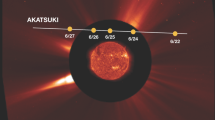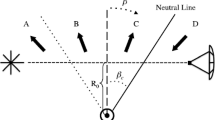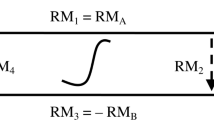Abstract
The coronal Faraday rotation (FR) experiments using the linearly polarized signals of the Helios-1 and Helios-2 interplanetary probes remain a unique investigation of the magnetic field of the solar corona and its aperiodic and quasi-periodic variations. The unexpectedly long lifetime of these spacecraft (1974 – 1986) enabled studies from very deep solar-activity minimum (1975 – 1976) into the strong activity maximum (1979). Important experimental data were also obtained for the rising (1977 – 1978) and declining (1980 – 1984) branches of the solar-activity cycle. Previous publications have presented results of the initial experimental data only for coronal-sounding experiments performed during individual solar-conjunction opportunities. This report is a more detailed analysis of the Helios FR measurements for the entire period 1975 – 1984. Radial profiles of the FR fluctuation (FRF) intensity recorded during the deepest solar-activity minimum in 1975 – 1976 are shown to differ distinctly from those during the strong solar-activity maximum in 1979. In particular, the decrease of the FRF intensity with solar-offset distance is substantially steeper in 1979 than in 1975/1976. In all cases, however, the FR data reveal quasi-periodic wave-like fluctuations in addition to the random background with a power-law spectrum. The dominant period of these fluctuations, recorded during 35 % of the total measurement time, is found to be close to five minutes. Large-scale FR variations at considerably longer periods (1.1 – 2.7 hours) were observed during 20 % of the measurement time. Knowing the intrinsic motion of the radio ray path from spacecraft to Earth and making a reasonable assumption about the solar-wind velocity, FRF observations at widely spaced ground stations have been used to estimate the velocity of coronal Alfvén waves. The velocity values range between 290 and 550 km s−1 at heliocentric distances between 3.5 and 4.5 R⊙ and are marginally lower (150 – 450 km s−1) at distances between 5.5 and 6.5 R⊙. Occasional FR variations with a period near 160 minutes and harmonics with periods 60, 30, and 20 minutes were also observed.











Similar content being viewed by others
References
Bird, M.K.: 2007, Coronal Faraday rotation of occulted radio signals. Astron. Astrophys. Trans. 26(6), 441.
Bird, M.K., Edenhofer, P.: 1990, Remote sensing observations of the solar corona. In: Schwenn, R., Marsch, E. (eds.) Physics of the Inner Heliosphere I, Springer, Heidelberg, 13.
Chashei, I.V.: 1989, Acceleration of the solar wind by Alfvén waves. Geomagn. Aeron. 29, 635 [Geomagnetizm i Aeronomiia 29, 718].
Chashei, I.V., Efimov, A.I., Samoznaev, L.N., Bird, M.K., Pätzold, M.: 2000, The spectrum of magnetic field irregularities in the solar corona and interplanetary space. Adv. Space Res. 25(9), 1973.
Efimov, A.I.: 1994, Radial profile measurements of the solar wind speed using radio sounding techniques. Space Sci. Rev. 70(2), 397.
Efimov, A.I., Andreev, V.E., Samoznaev, L.N., Chashei, I.V., Bird, M.K.: 1997, Control of solar wind formation by the coronal magnetic field. In: Wilson, A. (ed.) The Corona and Solar Wind Near Minimum Activity SP-404, ESA, Noordwijk, 337.
Efimov, A.I., Samoznaev, L.N., Andreev, V.E., Chashei, I.V., Bird, M.K.: 2000, Quasi-harmonic Faraday-rotation fluctuations of radio waves when sounding the outer solar corona. Astron. Lett. 26(8), 630.
Hollweg, J.V., Bird, M.K., Volland, H., Edenhofer, P., Stelzried, C.T., Seidel, B.L.: 1982, Possible evidence for coronal 1982, Alfvén waves. J. Geophys. Res. 87, 1.
Hollweg, J.V., Cranmer, S.R., Chandran, B.D.G.: 2010, Coronal Faraday rotation fluctuations and a wave/turbulence-driven model of the solar wind. Astrophys. J. 722, 1495.
Jensen, E.A., Bird, M.K., Asmar, S.W., Iess, L., Anderson, J.D., Russell, C.T.: 2005, CASSINI Faraday rotation experiment. Adv. Space Res. 36, 1587.
Jensen, E.A., Nolan, M., Bisi, M.M., Chashei, I.V., Vilas, F.: 2013, MESSENGER observations of magnetohydrodynamic waves in the solar corona from Faraday rotation. Solar Phys. 285, 71. ADS , DOI .
Kaplan, S.A., Pikel’ner, S.B., Tsytovich, V.N.: 1977, Plasma Physics of the Solar Atmosphere, Nauka, Moscow [in Russian].
Ogilvie, K.W.: 1978, A solar wind experiment for the solar probe mission. In: Neugebauer, M., Davies, R.W. (eds.) A Close-up of the Sun. 78–70, Jet Propulsion Laboratory, Pasadena, 345.
Parker, E.N.: 1987, Why do stars emit X-rays. Phys. Today 40(7), 36.
Schwenn, R.: 1990, Large-scale structure of the interplanetary medium. In: Schwenn, R., Marsch, E. (eds.) Physics of the Inner Heliosphere I, Springer, Heidelberg, 99.
Acknowledgements
This work was supported in part by the Program “Experimental and Theoretical Research of Solar System Objects” of the Presidium of the Russian Academy of Sciences and by Grant 13-02-00018 of the Russian Foundation of Basic Research (RFBR). This article presents the results of research partly funded by the Deutsche Forschungsgemeinschaft (DFG) under a cooperative program between the DFG and RFBR. We thank the referee for many helpful suggestions.
Author information
Authors and Affiliations
Corresponding author
Ethics declarations
Disclosure of Potential Conflicts of Interest
The authors declare that they have no conflicts of interest.
Additional information
Radio Heliophysics: Science and Forecasting
Guest Editors: Mario M. Bisi, Bernard V. Jackson, and J. Americo Gonzalez-Esparza
Rights and permissions
About this article
Cite this article
Efimov, A.I., Lukanina, L.A., Rogashkova, A.I. et al. Coronal Radio Occultation Experiments with the Helios Solar Probes: Correlation/Spectral Analysis of Faraday Rotation Fluctuations. Sol Phys 290, 2397–2408 (2015). https://doi.org/10.1007/s11207-015-0687-y
Received:
Accepted:
Published:
Issue Date:
DOI: https://doi.org/10.1007/s11207-015-0687-y




